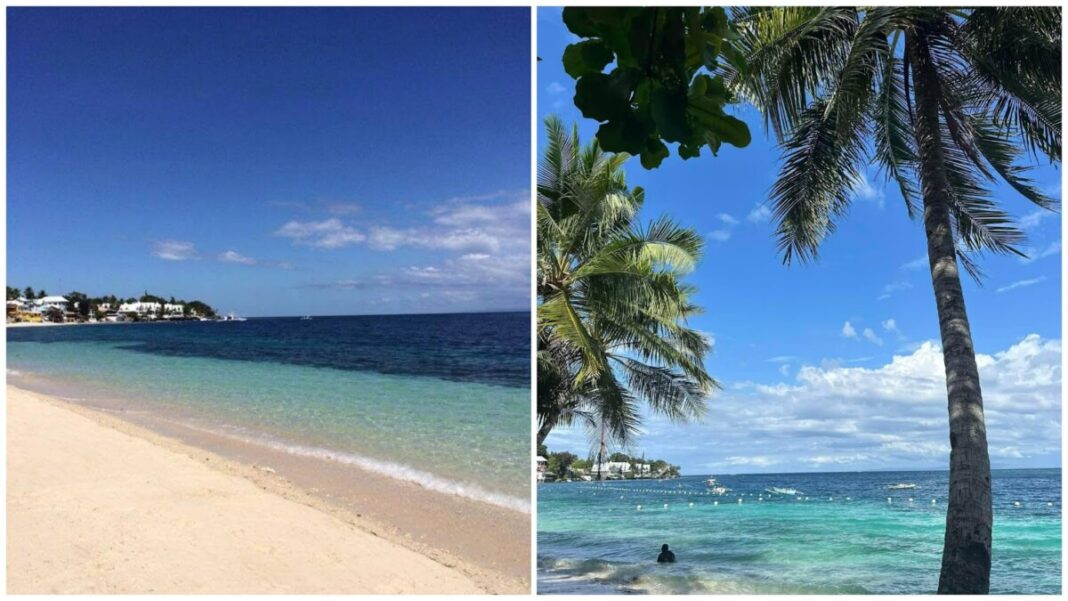Be the reason the reef still thrives, not why it disappears.
Tingko Beach in Alcoy reveals a fascinating natural wonder featuring a Mabad-on reef locally known as the Mambaje Reef. The living coral feature on the platform emerges like a flower sprouting during low tide, creating a walkable marine wonderland just meters from the shore. The transformation occurs daily, but it becomes most dramatic during the spring tide when it rises to 200 meters and becomes exposed. This phenomenon made Tingko Beach a favorite among tourists and locals for taking pictures and snorkeling, who match their visit during the tidal hours. At first, it appears as open water during high tide, and it becomes an interconnected series of tidal pools and coral gardens during low tide, offering a rare chance to explore marine life without going deeper into the water.




Fishin’ for Views
The beach itself features picturesque white sand framed by limestone cliffs and coconut palms that surround the island. At the right time, the reefs will reveal a whole show of corals, separated from the shore, and channel crystal waters not deeper than waist level. The natural lagoon biomes are designed for visitors to enjoy and participate in various fun activities. They can wade across to explore much further into the rich ecosystem. The tide features, including brain corals, sea anemones, and schools of tropical fish, remained visible in the glassy water, while sea urchins and starfish clung to the surface of the reef. The shallow depth of the sea makes it an ideal activity for novice snorkelers, who can fully immerse themselves in underwater visibility during calm conditions and pleasant weather.
Coral Lineage
The place is deeply rooted in Alcoy’s coastal culture, which was originally part of Barangay Daan Lungsod, formerly known as Mambaje, as this reef served as a navigation marker and fishing ground for generations of local fishermen. The municipal government now promotes Mabad-on reefs as a flagship attraction to promote ecotourism. Some locals share stories about the place, explaining how, before it was extended too far into the sea, it gradually retreated, which changed coastal currents over decades. It represents one of Alcoy’s last thriving nearshore corals, as it survives despite the pressures from climate change.
Look, Don’t Touch
To have a better experience during your visit, plan it for the early morning low tides. The local tourism office provides more accurate and up-to-date information, and hiring local guides can help you find the perfect spot for the most vibrant part of the section. The property offers basic amenities, including cottages, restrooms, and eateries located on the beachfront, where fresh seafood is available from local vendors. The weekends draw a much larger crowd, and the reef’s size ensures there are different contemplation corners for various scenes. Following the shore and adhering to tourism rules and regulations is encouraged, as visitors should be mindful of their surroundings and avoid stepping on and collecting the reefs, which helps improve, rather than destroy, marine life. The Alcoy Marine Sanctuary offers a range of activities to enjoy, not just for sightseeing but also for those who want to extend their experience.
How To Get There?
Exact Location: Alcoy, Cebu, Philippines
- By Car: The most direct route is to drive south via the Natalio Bacalso National Highway, which leads straight through scenic coastal towns like Sibonga and Boljoon. The entire trip typically takes about 1.5 hours, depending on traffic. You can use navigation apps such as Google Maps or Waze by typing in “Tingko Beach, Alcoy” as your destination. Parking is available near the beachfront, especially on weekdays when the area is less crowded.
- By Commute: hop on a southbound bus from the Ceres Terminal in Carcar that’s headed toward Oslob or Santander, just make sure it passes Alcoy. The bus ride usually takes a bit over an hour, and you can simply tell the conductor to drop you off at Tingko Beach in Barangay Daan Lungsod. From the highway, the beach is just a short walk away. To catch the reef at its best, aim to arrive early in the morning during low tide, and consider checking in with the local tourism office for tide schedules and area updates.
Mabad-on Reef stands as one of the most timeless natural masterpieces and an ecological treasure. Its daily appearance and disappearance mark a sway between the land and the sea. It also serves as a learning place to gain a deeper understanding of this unique phenomenon occurring in tidal ecosystems, as it is more than just a sightseeing spot that can only feed our eyes but also our minds. The Tingko beach offers much more, but it is also a reminder of the beauty of the planet’s rhythm and a call to preserve this place for future generations to come.

